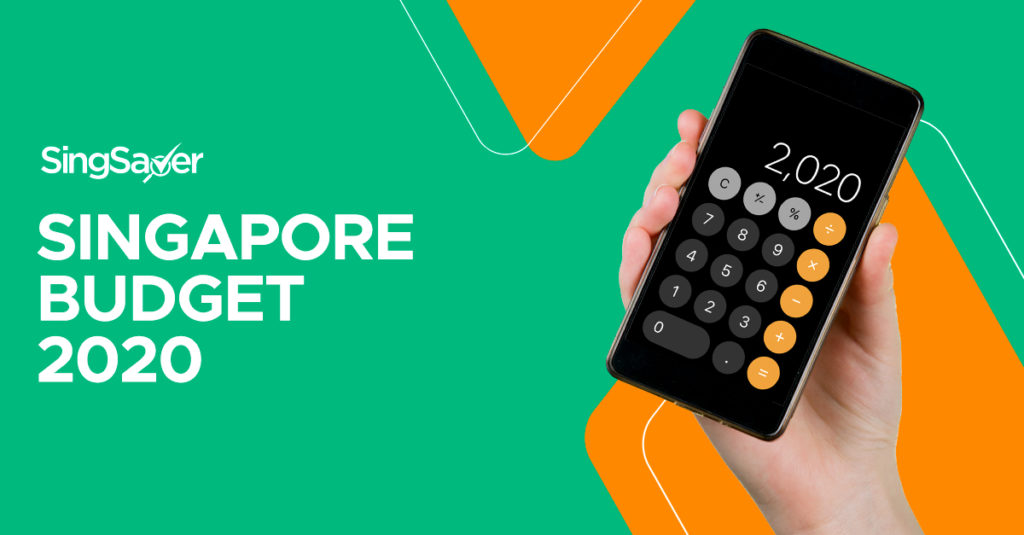
The Singapore Budget is the country’s fiscal plan for the current financial year that is planned with Singapore’s current and future needs in mind. This article will provide you with live updates on the key announcements made during SG Budget 2020.
Similar to the budget we set aside for our own expenditures, the Singapore Budget is planned so that Singaporeans can aim to spend wisely. You can get up to speed on what was announced during Budget 2019 with our quick recap.
On Monday, 17 February 2020, The Ministry of Trade and Industry (MTI) downgraded its economic growth forecast to between -0.5% and 1.5%, indicating a possible recession. Back in November 2019, the forecast was between 0.5% and 2.5% for 2020. The change in the economy forecast came through due to a weakened outlook after the outbreak of Novel Coronavirus (COVID-19).
This year’s budget is largely centred around the government’s plans to help Singapore families and lift our economy impacted by the ongoing COVID-19 outbreak.
Follow our Facebook, Instagram and Telegram for more updates.
Singapore Budget 2020 summary: 7 key highlights and announcements you need to know

Summary and highlights from Singapore Budget 2020:
1. $800 million support for COVID-19
A total of $800 million has been aside to help the economy recover from COVID-19, even as the severity and duration of COVID-19 remains unclear. The bulk of this will go to the Ministry of Health. This is on top of what’s already committed to public health every year.
Singapore’s economy grew by 0.7% in 2019 — recording the weakest growth since the 2008 financial crisis. Tourism and aviation are most directly affected by COVID including visitor arrivals and hotel occupancy. Affected supply chain created ripple effects on other sectors. The Ministry of Trade and Industry has downgraded GDP from 0.5-2.5% to -0.5-1.5%. Deputy Prime Minister and Minister for Finance Heng Swee Keat stated that Singapore must be prepared that the economic impact may be worse than predicted.
Here's a summary of the COVID-19 $800million package and additional support provided for 5 key sectors.
2. Stabilisation and Support package of $4 billion
The aim of this package is to help our workers stay employed in this time of slow growth.
A new cash grant will offset 8% of local workers’ wages for 3 months to help them stay employed amid the COVID-19 crisis. This will cost the government $1.3 billion and benefit all enterprises and their employees, and will be given by the end of July 2020.
To help enterprises with cash flow, there will be a corporate income tax rebate for the year of assessment (YA 2020) at 25% of tax payable, capped at $15,000 per company. This is to benefit all tax paying companies, costing the government $4 million. The wage credit scheme will also be enhanced to support wage increases for Singaporean workers.
3. GST to remain at 7% for 2021
The 2% increase in GST will not be implemented in 2021 keeping in mind the current state of the economy. However, the GST increase will still be needed by 2025, and the government will assess the appropriate time to announce it.
When the GST is raised, Singaporeans will be provided a $6 billion Assurance Package. This $6 billion will be set aside to cushion the impact of the GST increase. Households wIll receive offsets equivalent of 5 years worth of additional GST expenses incurred. Low-income households will receive offsets equivalent of 10 years worth of additional GST expenses incurred.
Singaporeans living in 1- to 3-room HDB flats will receive offsets equivalent to about 10 years worth of additional GST expenses incurred.
4. $8.3 billion to enable transformation and growth efforts
A total of $8.3 billion will be set aside over the next 3 years to help Singapore enable in its transformation and growth efforts. There are three main areas for this:
- Enabling stronger partnerships
- Deepening enterprise capabilities
- Developing our people
Our startup ecosystem is ranked in the top 15 for the global startup ecosystem report. As part of deepening enterprise capabilities, the government will set aside an additional $300 million under the StartupSG equity. The government expects to draw in more than $800 million of private funding in the next 10 years.
There are two packages as part of this transformation and growth efforts to help businesses:
Enterprise Grow Package
- Grow business platform
- Greater adoption of digital technology. Extend the SME Go Digital Program
- Help more enterprises enter new markets and enhance market readiness grant by expanding the support coverage
Enterprise Transform Package
- Enterprise Singapore to launch the Enterprise Leadership For Transformation programme that aims to support business leaders of small and medium-sized enterprises to help them achieve the next bound of growth
- Enterprise Development Grant to expand reach with the government expecting to support around 3,000 projects
5. Supporting lifelong learning with SkillsFuture Enhancements
Budget 2020 will help support Singaporeans acquire new skills in the midst of structural changes in the global economy. This will be done through the Next Bound SkillsFuture. The 3 key elements of this are:
- Enabling the individual
- Enhancing the role of enterprises in developing their staff
- Special focus on mid-career workers
(Individual) SkillsFuture credit top up of $500
All Singaporeans aged 25 years old and above will receive a SkillsFuture Credit top up of $500. This top up will be available from October 2020 and will expire by the end of 2025. This is to encourage Singaporeans to take action earlier to learn new skills and make the best use of this period of economic slowdown.
(Enterprises) SkillsFuture Enterprise credit at $10,000 per enterprise
To encourage employers to embark on the upskilling of workforce. This will help companies defray up to 90% of transformation costs. Most of the companies that stand to benefit from this will be SMEs. The Productivity Solutions Grant will also be expanded.
(Mid-Career Workers) SkillsFuture Mid-Career Support Package
This focuses on mid-career workers in their 40s and 50s to help them stay employable and move on to new jobs and new roles. The aim is to double annual job placements of people in their 40s and 50s.
The government plans to achieve this by:
- Increasing the capacity of reskilling programmes
- Providing hiring incentives to enterprises that hire those aged 40 and above through a reskilling programme. Government will provide 20% salary support for employers for 6 months, capped at $6,000 in total.
- Giving peer-level support and career guidance through a group of volunteer Career Advisors
6. CPF and increased retirement support for seniors
A. Senior Workers Support Package
With the impending raises in retirement and re-employment ages, the Senior Workers Support Package will be rolled out. This is to help seniors remain active and contribute to society and economy by supporting lifelong employability. The package includes:
- Senior Employment Credit: To provide employers with wage offsets when they hire Singaporean workers aged 55 and above.
- CPF Transition Offset: This will help employers to offset half the increase in employer CPF contribution rates in 2021
- Senior Worker Early Adopter Grant: To support companies that increase their own retirement age and re-employment age above the statutory minimum.
- Part Time Re-employment Grant: To support companies that voluntarily commit to providing part-time re-employment to all eligible older workers who request for it.
B. Enhancing Silver Support and Lease Buyback Scheme
The Silver Support Scheme and the Lease Buyback Scheme will both be enhanced.
For the Enhanced Silver Support Scheme, quarterly cash payouts will be raised by 20%. Eligibility criteria will be expanded to cover more seniors. A new payout tier will also be introduced to provide a smaller payout to seniors whose monthly income falls between $1,300 and $1,800. Currently, these senior citizens do not receive the benefits.
C. Matched Retirement Savings Scheme
To help those with less CPF savings to save more, the government will introduce the Matched Retirement Savings Scheme.
Lower income Singaporeans aged 55 to 70, who have not been able to set aside the Basic Retirement Sum (BRS) will be eligible. Under this scheme, the government will match the cash top-ups to the CPF Retirement Account, up to a maximum of $600 per person annually from 2021 to 2025. The government has stated that 435,000 Singaporeans will be eligible for this scheme.
7. $1.6 billion Care & Support Package for households
This Care And Support Package will help to alleviate concerns of rising cost of living. All Singaporeans aged 21 and above will receive a cash payout depending on their income in 2020. Singaporeans under a lower income group will receive additional help with living expenses.
U-Save Special Payments: The GST-voucher U-Save rebates are extended for another year and will be doubled through a one-off special payment to all HDB households. These rebates will range between 1.5 to 3.5 months.
Lower-income Singaporeans:
- Workfare Special Payment: Singaporeans on workfare will receive an additional 20% of their income from 2019 with a minimum cash payment of $100
- Grocery vouchers for lower income households: Needy households will receive grocery vouchers of $100 each year in 2020 and 2021
Additional vouchers for families with children and elderly:
- Families will receive $100 cash payout for every adult with at least one Singaporean child aged 20 and below this year
- Additional GST voucher U-Save rebate for households with 5 or more members to help them with the utility bills. In total, larger households can receive up to $1,000 in U-Save rebates depending on their flat type
PAssion Card top up of $100:
There will be a $100 top up to PAssion Card for all Singpaoreans aged 50 and above in 2020, including the Pioneer and Merdeka Generations. Those without a PAssion Card can receive one for free to receive the top-ups.
8. Addressing climate change and sustainability
Cleaner energy vehicles
To encourage environmentally clean vehicles, four key measures will be carried out.
- Commercial Vehicle Emissions Scheme: This will be introduced for light goods vehicles
- EV Early Adoption Incentive: Buyers of electric vehicles can get rebates of up to 45% on the Additional Registration Fee, capped at $20,000 per vehicle
- Road tax methodology for cars to be revised
- Expand EV charging infrastructure: To get 29,000 chargers island-wide
The government will also take the lead and use cleaner vehicles themselves.
Adoption of energy-efficient appliances
Encourage households to purchase energy-efficient appliances by introducing incentives to lower the cost of these appliances.
New HDB Green Towns Programme
There will be a new HDB Green Towns Programme introduced to make sustainable living a key feature for HDB estates. This programme has three key areas of focus:
- Reduce energy consumption
- Recycling rainwater
- Cooling HDB towns
Coastal and flood protection fund: The government will inject an initial $5 billion into this fund.
A generous budget
Singapore Budget 2020 will see an overall budget deficit of $10.9 billion (2.1% of GDP) and no draw on past reserves.
Read these next:
Singapore Budget 2020: $800 Million For COVID-19 Recovery Package
Singapore Budget 2020: Next Bound SkillsFuture And What You Need To Know
How Singapore Budget 2020 Affects HDB, CPF & Living Costs
A Look Back At Singapore Budget 2019 Highlights
Will My Travel Insurance Cover Novel Coronavirus (COVID-19)?









